The white pocket square is a subtle yet sublime menswear accessory. But even though it’s small and simple, it can be the perfect accent piece to finish an outfit. So, let’s explore just why this accessory is such a powerful item, and how you can use it to elevate your menswear looks.
The white pocket square can be an understated finer point for casual and business ensembles, and is a necessity for semi-formal and formal dress. Few things can add so much to a look with so little as a white pocket square can, and by that, we mean a true white square, as just pulling out the lining of your breast pocket isn’t a viable option.
We often emphasize the rainbow of color options you’ve got available to you, like in our post about pairing your pocket squares with your shirts and ties. Still, ironically it can be the plain white pocket square that’s the most difficult to get perfectly right.
You might think it quite reasonable to ask, “It’s just a white pocket square! How could anyone mess that up?” Well, in fact, it is the finer points, the details, and minutia that set apart an acceptable square from an exceptional square. From today’s guide, you should learn exactly what to look for.
One more note before we dig in further, though, we’re not talking about white pocket handkerchiefs here. A pocket square is a decorative element meant to elevate your look, whereas a handkerchief is a utilitarian tool that isn’t meant to be displayed. For the easiest way to remember the difference, just look to the old saying, “One is for showin’; the other’s for blowin’.”
History of The Pocket Square
In antiquity, nobles from Babylon to Egypt and Greece to Rome were known to carry squares of fabric on their person. These were usually dipped in perfume or fragrant oils to help mask unpleasant odors, similar to how one might use a sachet.
A cloth was also commonly carried by people of all stations to mop up a sweat or other messes. It didn’t become a fashion accessory in the West until the late 14th century. King Richard I of England, who was often mocked for his foppish dress and luxurious habits, was ridiculed for commissioning from the royal tailor pieces of cloth used to wipe his mouth and nose.
Within a century, nobles and royals all across Europe like Caterina de’ Medici and Elizabeth I were seen sporting ornate handkerchiefs on their person. And as part of his efforts to standardize manufactured goods, King Louis XVI of France even mandated that the official size for a handkerchief be 16 inches square.
Because these articles were so fine and valuable, most people actually tried to avoid using them to wipe their faces. This is where the distinction between the pocket square and the handkerchief started to develop.
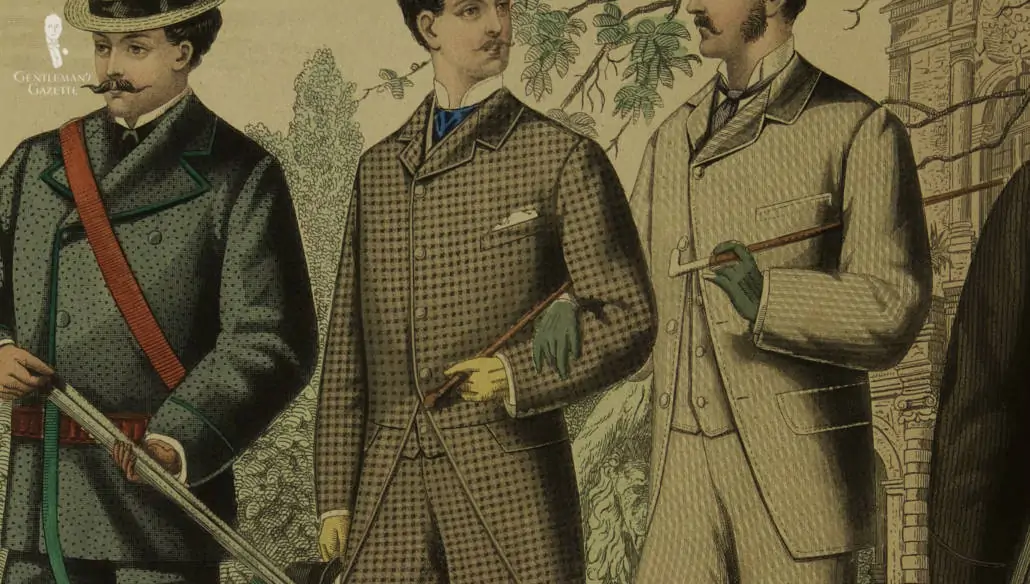
With the rise of the modern suit in the 19th century, gentlemen settled on putting their fine pocket squares in their jacket’s breast pocket and reserving inner jacket pockets or trouser pockets for their handkerchiefs. This, then, was when the pocket square found its permanent home.
While suit-wearing isn’t quite as popular today as it used to be, we’re sure that any style connoisseur will agree that a breast pocket looks particularly bare without a pocket square.
What Makes A Good Pocket Square?
Overall, a good pocket square will hold folds well, sit attractively and securely in the pocket, and remain looking elegant while doing so. The most important factors are material and size for retaining shape and position, so we’ll cover those first.
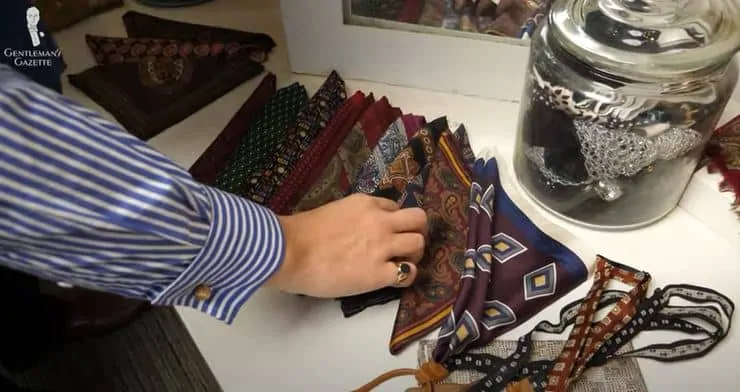
White Pocket Square Materials
Nothing is going to affect overall functionality more than material, and it is probably the most important choice you’re going to make. So, let’s take an in-depth look at the most common materials used and what you need to know about them.
1. Cotton
Cotton is often used to make inexpensive pocket squares because it’s relatively cheap and easy to clean. But, many cotton weaves can crease in an unattractive way, don’t hold folds particularly well, and can go limp if not pressed regularly. So, unless you’re sticking with a classic straight fold, a cotton square is best used as a handkerchief and not a pocket square.
There are exceptions for particular weaves, and one of these is cotton flannel. Cotton flannel is a medium-weight cotton with an iconic napped appearance, an exquisitely soft and unique texture that gives the fabric more hold, and it’s less prone to unsightly creasing, so it can be used for both edged and puff style folds.
Many white cotton pocket squares can look a bit plain, which, again, is where quality and craftsmanship come into play. For example, Fort Belvedere offers a distinctive cotton flannel pocket square in white that’s made from 100% Italian cotton in a subdued twill weave, and it’s the ideal way to sit securely and elegantly in your pocket.
2. Silk
With its unique sheen and soft feel, silk is particularly popular for pocket squares, including white ones. But, as we emphasize in our guide on madder silk, its ability to hold and radiate lustrous color and fine detail is one of its key strengths. So, in a sense, silk is wasted on a plain white pocket square.
Visual interest can be added with a more complex weave like jacquard, dupioni, or faille. Even a plain white silk pocket square can still look elegant under the right circumstances if you’re going for a certain understated flare. But, keep in mind that it will probably look best in a puff fold and not so much in any other orientation.
3. Wool
Unlike the ever-popular silk pocket square, pocket squares made from wool are relatively rare and thus an accessory for the true connoisseur. In white, they have a subdued and understated appearance and pair well with suits in flannel or other heavier-weight fabrics. They can hold simple folds very well, but they tend to look bulky with complex, layered, or even puff folds.
In the Fort Belvedere shop, we don’t carry a pocket square in white in pure wool because we feel that wool is better used for adding pops of color to a heavier-weight winter ensemble.
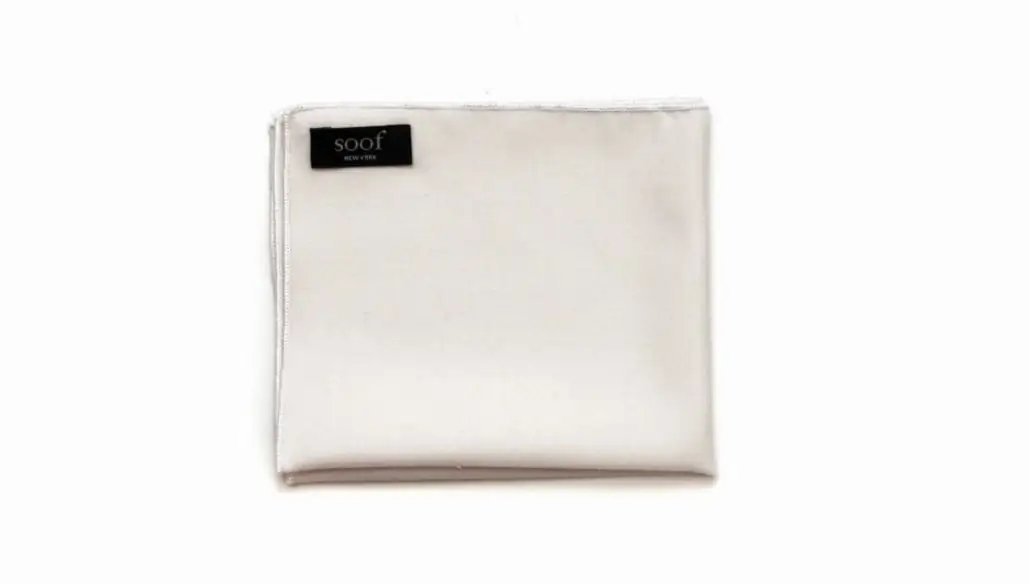
Perhaps the ideal solution for reaping the benefits of both wool and silk is to put them together. And, as such, we offer several different silk-wool pocket square blends in the Fort Belvedere shop. With these, you’ll get the structural integrity of wool and the lovely outward appearance of silk.
However, as in other cases, we believe that these are maximally used in colorful options to best take advantage of the natural characteristics of the two fabrics.
Still, even as a white pocket square, silk-wools are easy to fold, hold their shapes relatively well, and aren’t as shiny as pure silk. So, if you’re looking for something that falls fairly equally between silk and wool without the distinct characteristics of either, this blend might be a good choice for you.
4. Linen
Along with silk, linen is also one of the most popular materials for pocket squares, and for good reason. It’s stiff enough to hold its shape for both simple and complex folds, and the variety of weave options available create a plethora of visual interest.
From heavy damask linen to light and delicate cambric linen, originally made in Cambrai, France, unique textures make linen one of the best materials for white pocket squares.
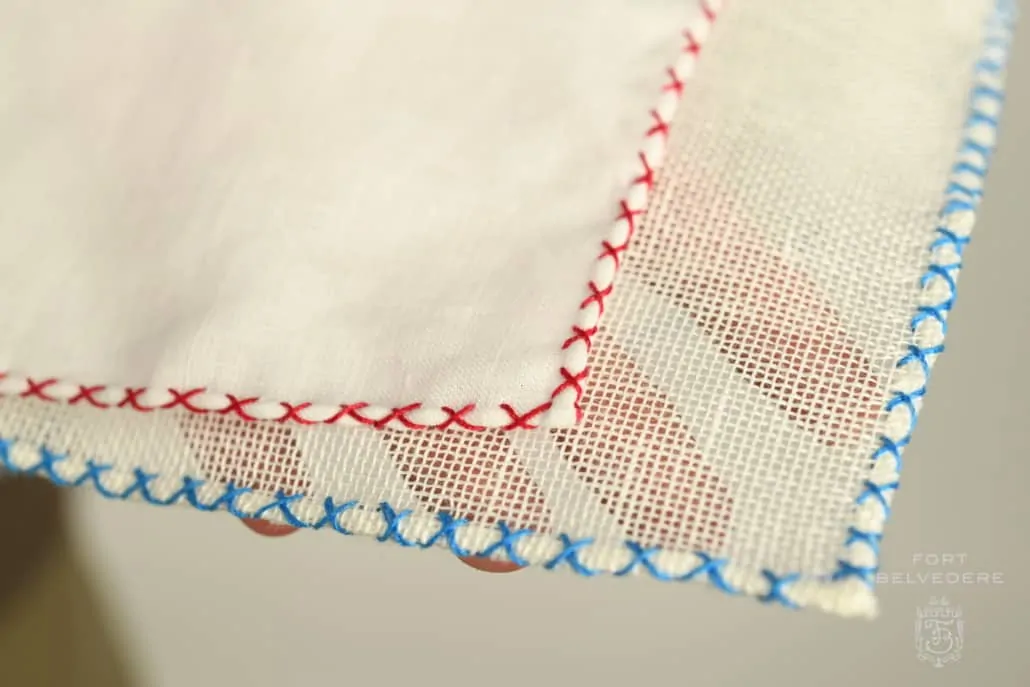
For a look that’s sure to set you apart, consider this handcrafted, open weave linen. It’s great for warm weather, and it’s sure to draw a bit more attention to your pocket. In addition to this looser weave, Fort Belvedere also offers a linen weave that’s a bit less stiff as well.
Thanks to the skilled artisans of Italy and their antique looms, we’ve managed to create a white linen pocket square that’s as soft as cotton but with all the elegant appeal of linen. It’s great for all seasons and all folds, making this linen pocket square one of the most versatile options available on the market.
This versatility can be approximated with cotton-linen hybrids, but in our experience, it’s best to go with this 100% pure, softer weave linen.
5. Synthetics
Continuing on things to avoid, long-time viewers will know that we at the Gentleman’s Gazette try to eschew all synthetic fabrics whenever possible. These don’t breathe well, they’re harder to clean, their manufacturing is often detrimental to the environment, and, generally, they just look “off.” This is certainly true with the common synthetic alternatives used for white pocket squares.
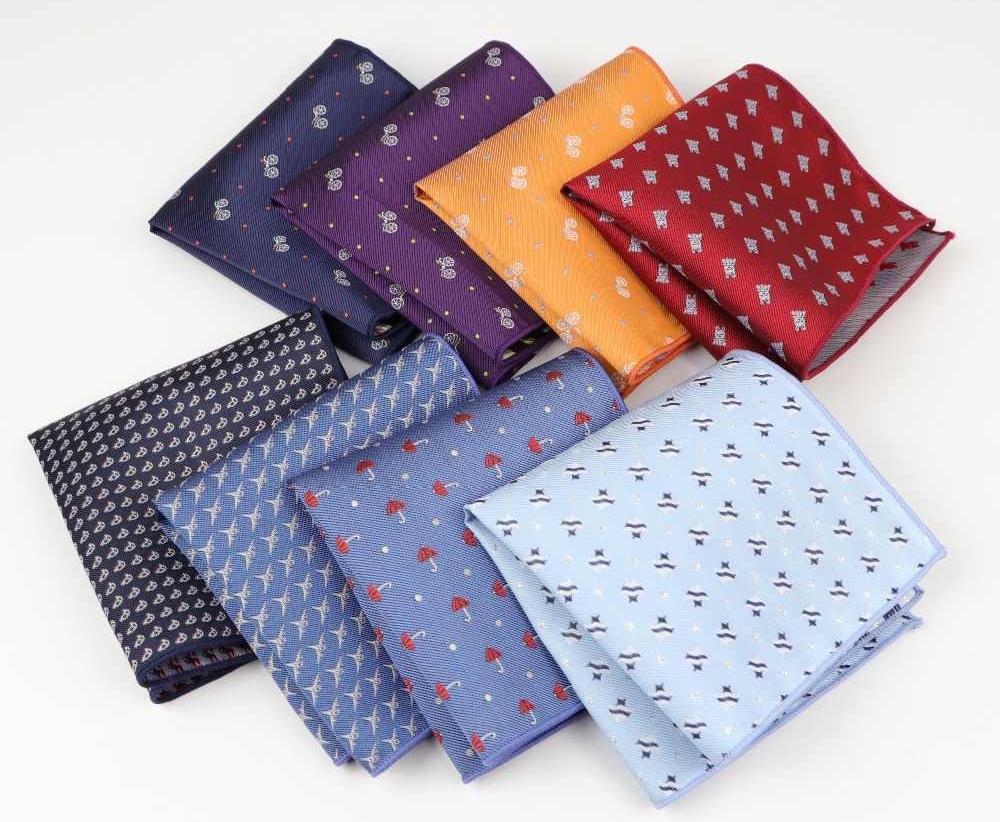
The most common of these is probably polyester, which is often used as an alternative to silk. It has an overly slick texture that can be unpleasant to touch, and it often looks too shiny.
Another common silk alternative is acetate, which has all of the problems of polyester and, on top of that, is likely to tear or wrinkle even more easily.
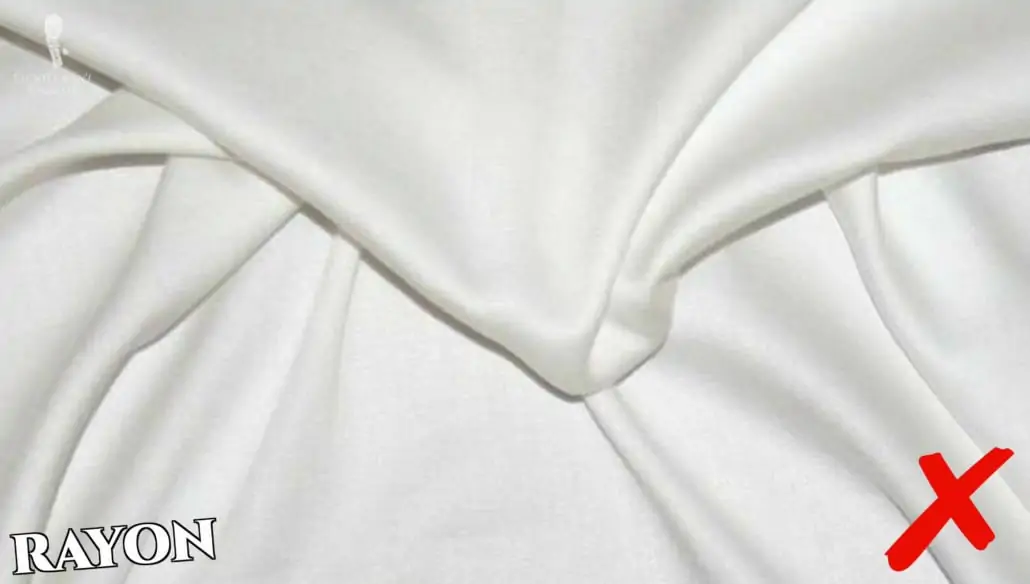
Rayon is used as an alternative to cotton and linen, but it’s more difficult to clean, and fades and bleeds easily.
So, as with many things in life, it’s probably best to keep your pocket squares au naturel.
Ideal Size(s) for White Pocket Squares
The next main consideration when looking for a white pocket square is size. Louis XVI may have decreed that all pocket squares should be 16 inches square in size, but, at the risk of lèse-majesté, we have to disagree–though we don’t want to lose our heads over it!
The size of a pocket square is important as it will be a major determining factor in how well it sits in your jacket pocket. If it’s too small, it’s constantly going to slide down, becoming unseen. And if it’s too large, it can bunch up and create unsightly interruptions in the line of your jacket’s chest area.
Standard sizes vary from around 10 inches square (25 centimeters square) for heavier fabrics like wool tweed, up to 18 inches square (46 centimeters square) for some silk varieties.
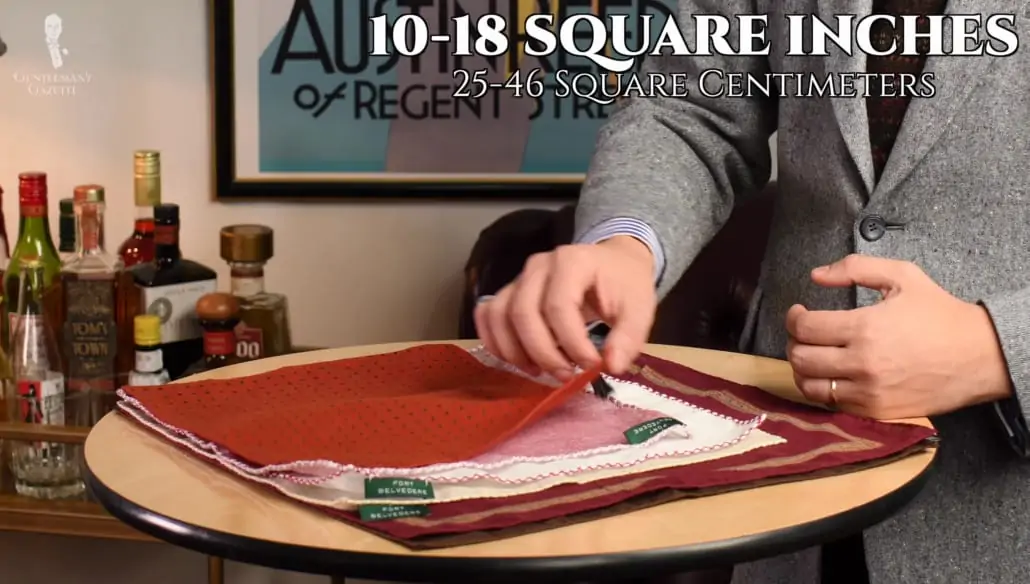
On that note, a closely related consideration to keep in mind here is the material of your pocket square, as slicker silks are going to tend to slide down into your pocket more. In contrast, heavier and coarser weaves are more likely to bunch up. Generally, you’re going to want pocket squares in thicker fabrics to be smaller and pocket squares in thinner, smoother fabrics to be of a larger size.
As such, be wary of any retailer that sells all of their pocket squares in the same dimensions, regardless of the material used. At Fort Belvedere, pocket square sizes are dictated by what looks the best, not what costs the least.
For every fabric type we offer, we tested eight different sizes of squares, and this rigorous testing yielded some interesting results. For instance, the heft of our cotton flannel pocket square allowed it to keep its form at the rather small size of 12 inches square, the softer Italian linens sat better at 13.75 inches square, while the stiffer Irish linen worked best sized at 15 inches square.
Edges & Edge Stitching
Beyond material and size then, the next most important consideration for a white pocket square would be the details of its construction. We’ve already dealt with weaving methods and general craftsmanship in the materials section, but when determining the quality of a pocket square, how its edges are finished is also an important consideration.
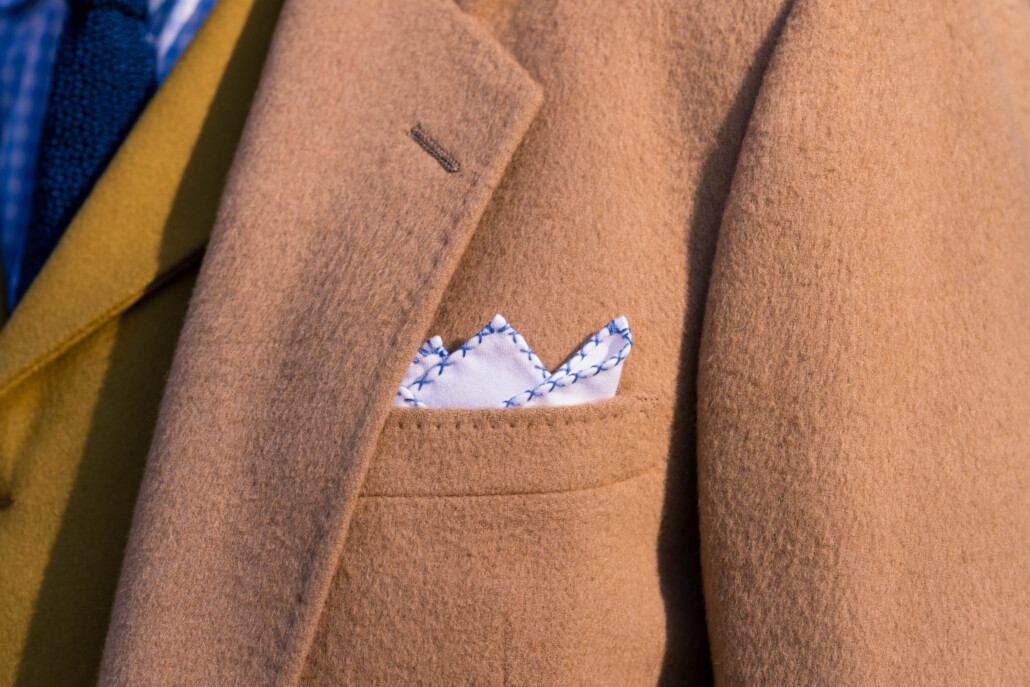
Pocket square edges can be finished in one of two ways: hand-rolled or machine-stitched. We go into greater detail about these construction techniques in our guide, but, to summarize, it’s just as you might expect. Machine-stitched edges are folded over and simply stitched by a machine, whereas hand-rolled edges are carefully rolled by hand and then stitched by hand as well.
If the edge is rolled to the obverse or front side of the pocket square, it’s referred to as a French roll, whereas if it’s rolled to the reverse or backside, it’s referred to as an Italian roll. And, just like a fine Cuban cigar, hand-rolled is always going to be better than machine-finished.
Hand-stitching will allow for just enough malleability for the pocket squares fabric to drape, puff, and fold attractively. Meanwhile, machined edges are often going to look too rigid overall. Hand-stitching also allows the artisan to miter the corners, making them thinner and easier to fold. But, with a machine, the edges have to be folded on top of each other, creating an overly bulky look.
Finally, here, hand-rolled edges are less likely to come apart and unravel, adding to the longevity of your pocket square overall. Keep in mind as well that edges also have an aesthetic function when it comes to white pocket squares.
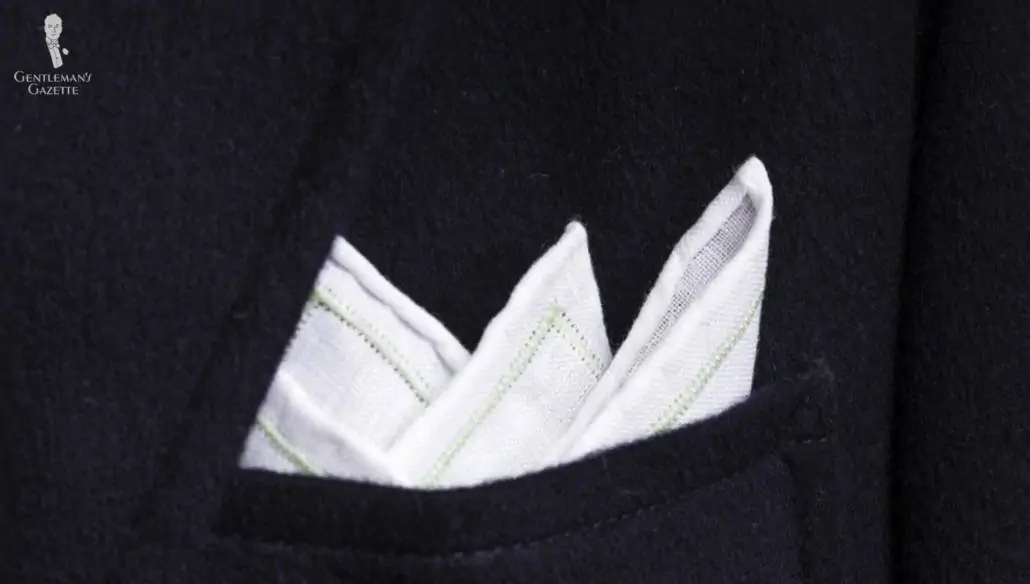
Silk pocket squares tend to have soft edges that aren’t very noticeable, so they won’t function as much of a decorative element unless they’re bordered. Cotton, wool, and linen pocket squares, on the other hand, often have stiffer edges. These are sometimes incorporated into the overall look of the square with details like creative stitching, colors, textures, and patterns.
Further Pocket Square Details
A great deal of the visual interest of a white pocket square comes from its materials and the natural texture found in its weave, as we discussed previously. But, additional detailing can also add an extra pop that will really complement some looks. Our first example of this would be stitching.
1. Stitching
With hand-rolled edges, you can sometimes find exposed edge stitching that serves as a decorative element. It’s often found in a contrasting thread to present more of a pop of color.
X-stitching is a renowned pattern that is particularly difficult to execute well, which is why we’re so proud of the x-stitched pocket squares available in the Fort Belvedere shop.
2. Edging
Edging involves adding or subtracting fabric from the edge of the pocket square. With pin-spoke edging, for example, tiny repeating shapes are cut into the border of the pocket square, which has a nice rustic effect.
Conversely, some pocket squares will have a laid-on border. Historically, adding lace to the edges of pocket squares was exceedingly popular and, though it’s largely fallen out of fashion for men today, you can still sometimes find pocket squares with lace edging or ones made entirely out of lace, usually cotton or linen.
These are definitely going to be statement pieces, of course, and you’ll want to have a supreme amount of confidence to wear them, lest you be accused of having a doily in your pocket.
3. Micro-Imagery
On more casual white pocket squares, it’s not unusual to find examples with imagery, usually embroidered in the corner or on the border. This method is used in various circumstances, including honoring an organization like the Masonic Order, a hobby like fishing, or commemorating a special union. But, if one goes too far, it’s easy for this embroidery to look overdone and tacky.
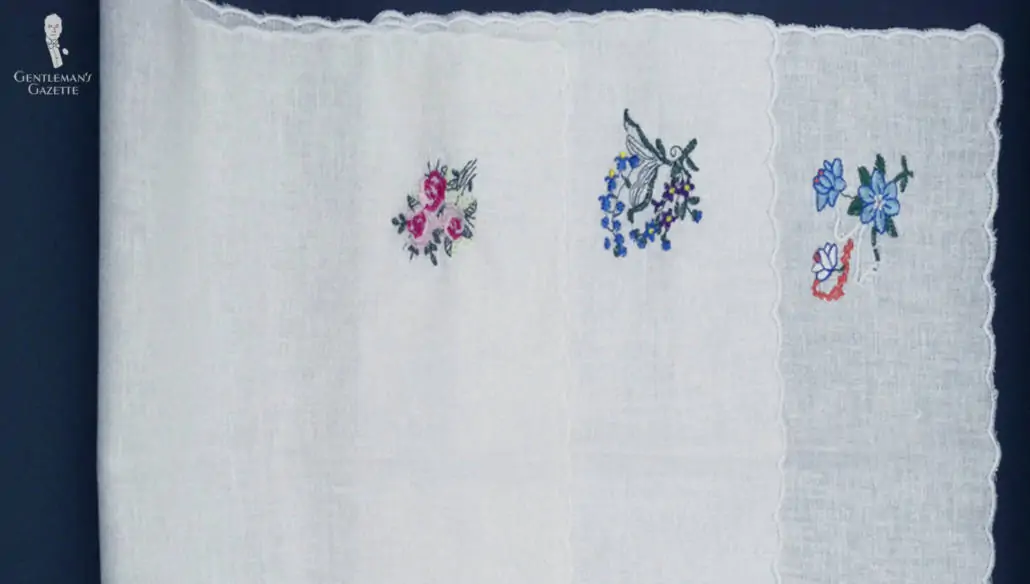
So, we would recommend restricting yourself to more simple patterns, such as a versatile polka dot style, which we have available in the Fort Belvedere shop. Alternatively, you could consider our Four Suits pocket square, which we’re sure would be Sammy Davis Jr. approved! Overall, focus on understated designs that are still interesting and fun.
4. Macro-Imagery
Moving from the micro to the macro, with some pocket squares, you might find patterns or figuration woven directly into the fabric. This is especially common, for example, with jacquard silk and damask linen.
Personally, we wouldn’t really consider these articles to be true white pocket squares as the excessive patterning gives them an ornate level of detail that’s essentially functioning in the same way that colors would, even if the pocket square happens to be monochromatic.
And when applied to pocket squares, these fabrics also tend to put us a bit too much in mind of rented suits, so we’d recommend that you leave them to tablecloths and upholstery.
5. Logos
As with heavy detailing, we also believe that logos and brand names don’t really belong on a white pocket square. To ensure that you never have to worry about someone else’s name or symbol poking out from your pocket, Fort Belvedere branding is intentionally discreet.
Along those same lines, unless you actually happen to share your initials with a certain monsieur Louis Vuitton, you may want to consider monogramming your own initials onto your pocket square instead.
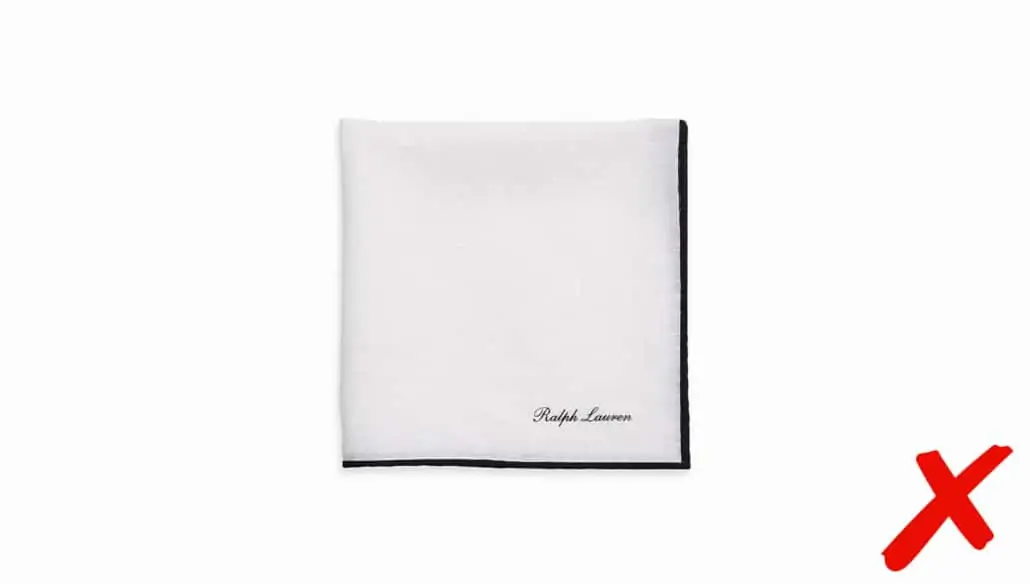
In our dress shirt guide, Raphael explains why we feel that monograms on shirts should be more discreetly hidden. But, when it comes to pocket squares, the situation is a bit different.
While shirts were traditionally monogrammed as a utilitarian concern to tell them apart in the washing or at the dry cleaners, pocket squares were traditionally monogrammed as a way to set the wearer apart while wearing them. Therefore, a more prominent location and a more elegant script are perfectly acceptable.
When embroidered in contrast stitching, gentlemen traditionally use dark or jewel tone thread to achieve a distinctive look. But, with a white pocket square, the most refined and sophisticated look is achieved by using the same color embroidery, which is to say, white.
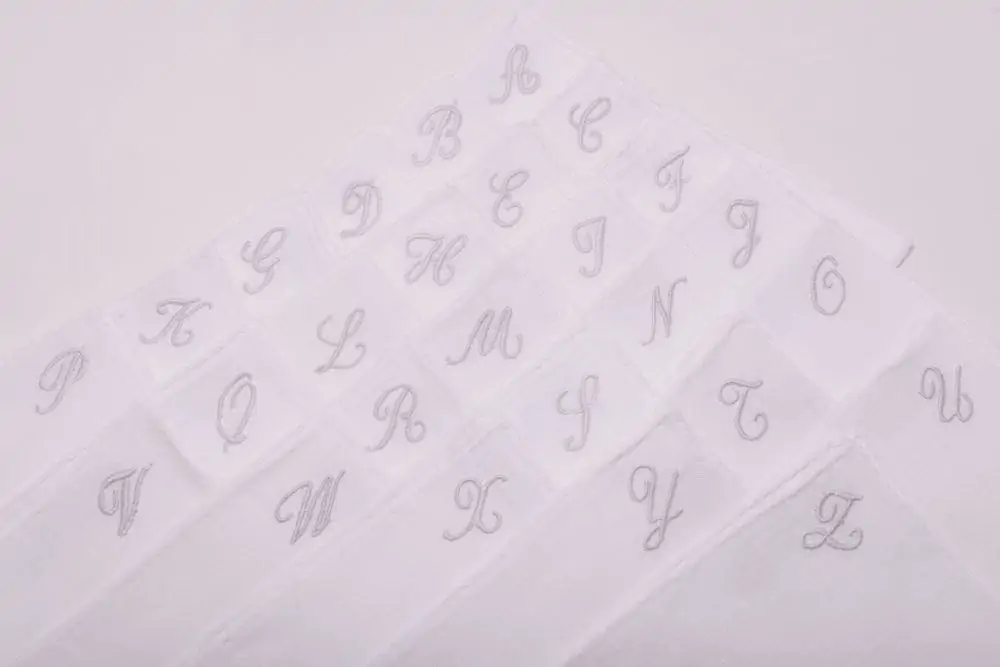
As such, at Fort Belvedere, we offer linen pocket squares that are hand-embroidered with one initial in a subtle white thread with a very high stitch count and a slightly raised profile. The result is a monogram tasteful enough to be displayed as the center point of a crown fold or hidden away if desired.
With all this said, the amount of detailing and what kind of detailing you have on your pocket square will largely be dictated by where you wear it.
Where to Wear Your White Pocket Square
A white pocket square can, of course, be worn literally anywhere you’re going to wear a jacket, from the least to most formal of occasions. But, subtle components are going to change from occasion to occasion.
1. Casual Social Events
Because white is supremely versatile, you truly have carte blanche when pairing your white pocket squares with more casual ensembles. Therefore, we recommend having some fun with it. Consider a colorful, contrasting x-stitch, or go with a piece of colorful embroidery. Again mentioning our Four Suits pocket square, for instance, it might bring you some good luck on a poker night.
To dress up a casual look with a bit of foppish flair, you could consider a white silk square in an elegant and exuberant puff fold. And, for something more understated yet still a bit playful, you could consider open weave linen.
2. Office Settings
Moving next to office settings, you could probably pull off most of the looks we just mentioned in a more casual office. In more formal settings, though, you’ll want to avoid silk or shiny silk-wool as well as embroidered detailing.
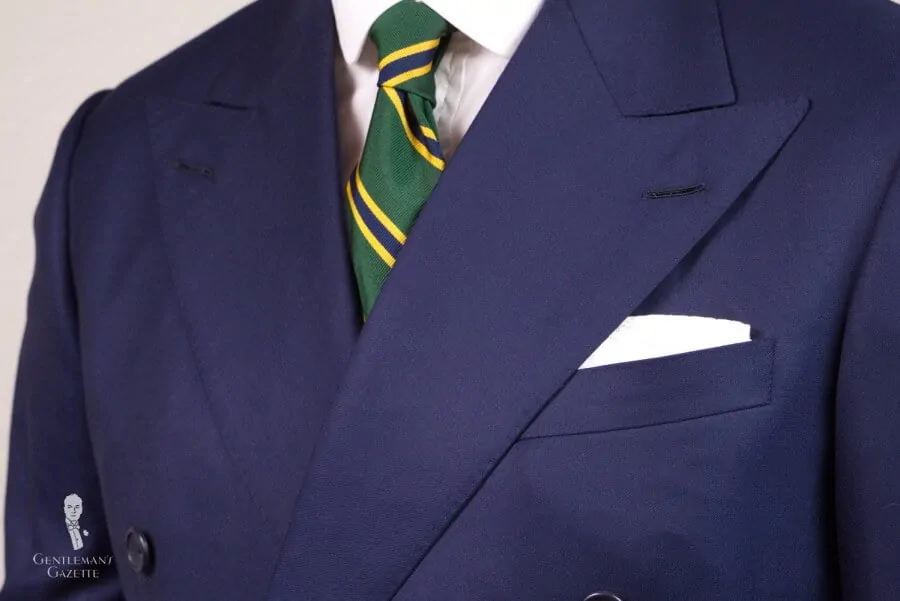
Instead, we’d recommend sticking to linen or cotton flannel with plain edges or contrast stitching in subdued colors. And, of course, simple folds like the straight fold or, perhaps, a crown fold are going to be your best bets here.
3. Semi-Formal
For semi-formal social and business events like weddings or garden parties with clients, you’re still going to have ample room for a bit of creative self-expression. You might consider traditional or open weave linen with plain or contrast stitching in a fun color if desired and in a more conservative fold like the straight fold or crown fold.
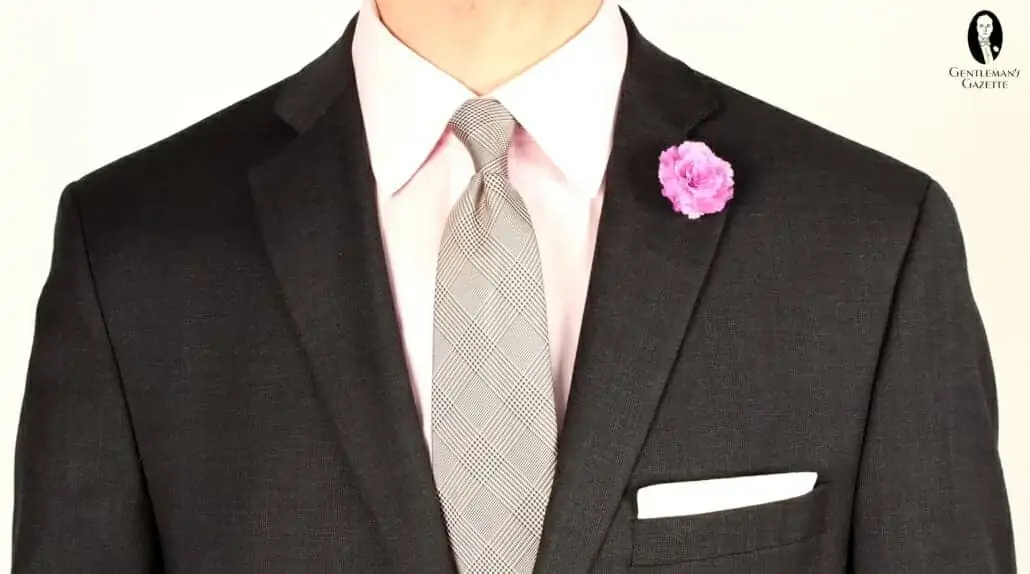
4. Black Tie
Moving up to Black Tie, for a classic look, you could consider a plain-edged linen square in a classic one or two-point fold. Remember that formal events are so elegant because they adhere to time-tested rules, which also holds true for pocket squares.
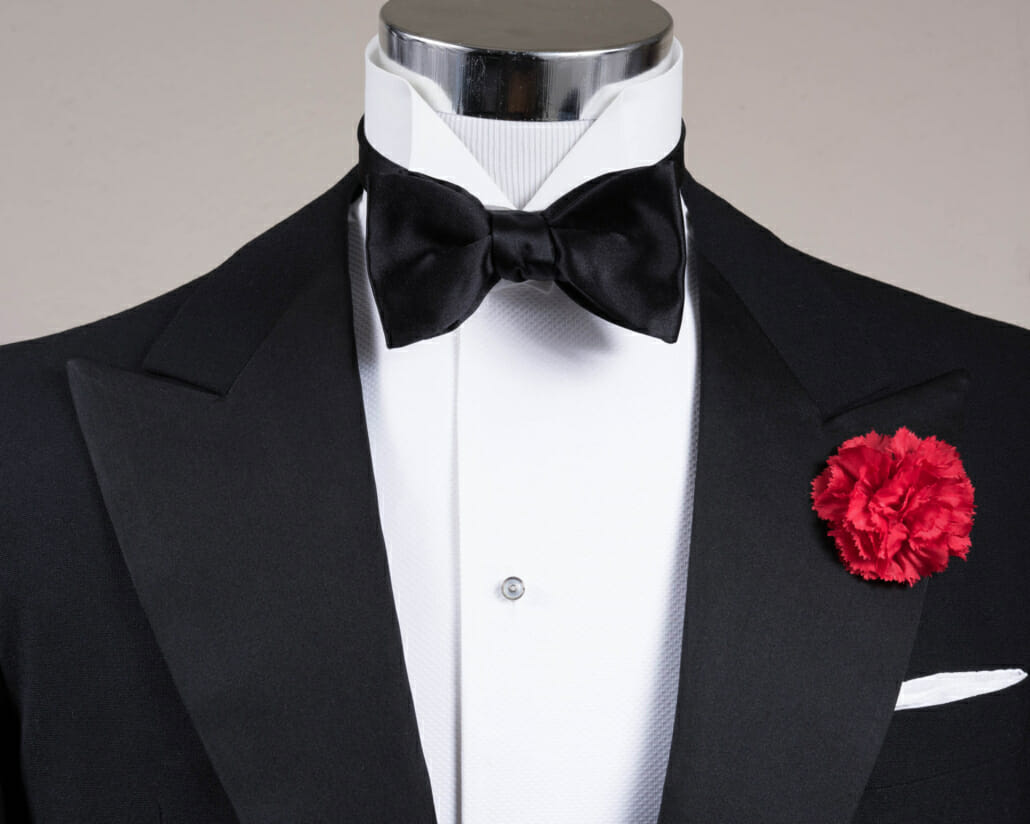
5. White Tie
For both morning wear and White Tie, we would recommend going no bolder than a plain-edged, white linen pocket square, perhaps with an embroidered initial if you so choose. The straight fold is most traditional here, but you could consider a rabbit ear, puff, or shell fold for something a bit bolder.
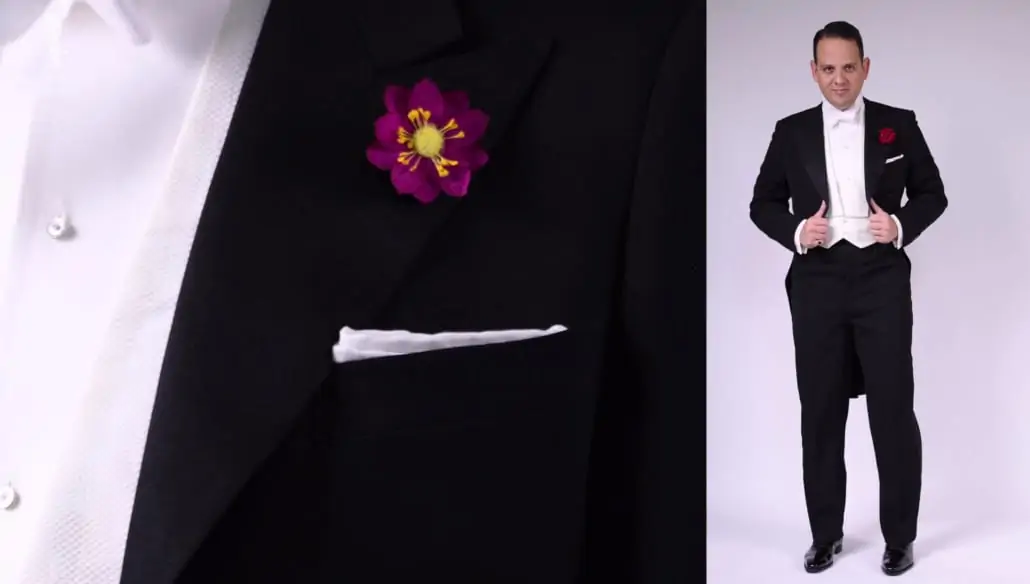
Price: What to Spend on a White Pocket Square
As you may have guessed, the cost of a pocket square will be dictated primarily by materials, construction, and detailing.
As a general rule, you’re probably going to want to pay between $40 and $80 US dollars for a quality pocket square. Anything under $15 will probably be made from inferior materials, and anything under $30 or so will probably lack finer points of detailing.
Depending on the materials used, the $40 to $80 price point will probably be the sweet spot for quality in terms of construction. Of course, an accessory as timeless as the white pocket square will be able to be worn for years indefinitely if you take good care of it. As such, this will give you a relatively low cost per wear.
Be wary when purchasing anything for over $100 or so, though, unless it has details like fine Italian lace or hand-done embroidery, as there’s a good chance you’re going to be paying more for the name brand of the pocket square and not for its quality.
We hope that the offerings we mentioned from the Fort Belvedere shop caught your eye and, by the way, buying pocket squares in the shop in increments of 3, 6, or 12 will net you some considerable savings, so you might want to consider stocking up.
Outfit Rundown
Today, I am, of course, wearing a white pocket square and I’ve based my look around it simply using the grayscale. The square, which is from Fort Belvedere, is made from 100% fine Italian linen with hand-rolled edges and I’ve got it oriented in a crown fold today.
Other accessories from Fort Belvedere today include my platinum-plated sterling silver eagle claw cufflinks, featuring black onyx as the stone, my two-tone solid socks in black and white, and my black knit tie, featuring a fine horizontal stripe in white. My simple white boutonniere is a prototype design, but it fits into the grayscale feel of the outfit.
My tweed herringbone jacket lends a bit of casual flair to the outfit, and while it is gray, it does also contain subtle tones of brown and green. My shirt features narrow stripes in gray and white, my trousers are plain black, and my shoes are black single monk straps from Velasca.
For all of the Fort Belvedere accessories I’m wearing today, as well as, of course, a wide array of different pocket square styles in white and otherwise, consider visiting the Fort Belvedere shop.
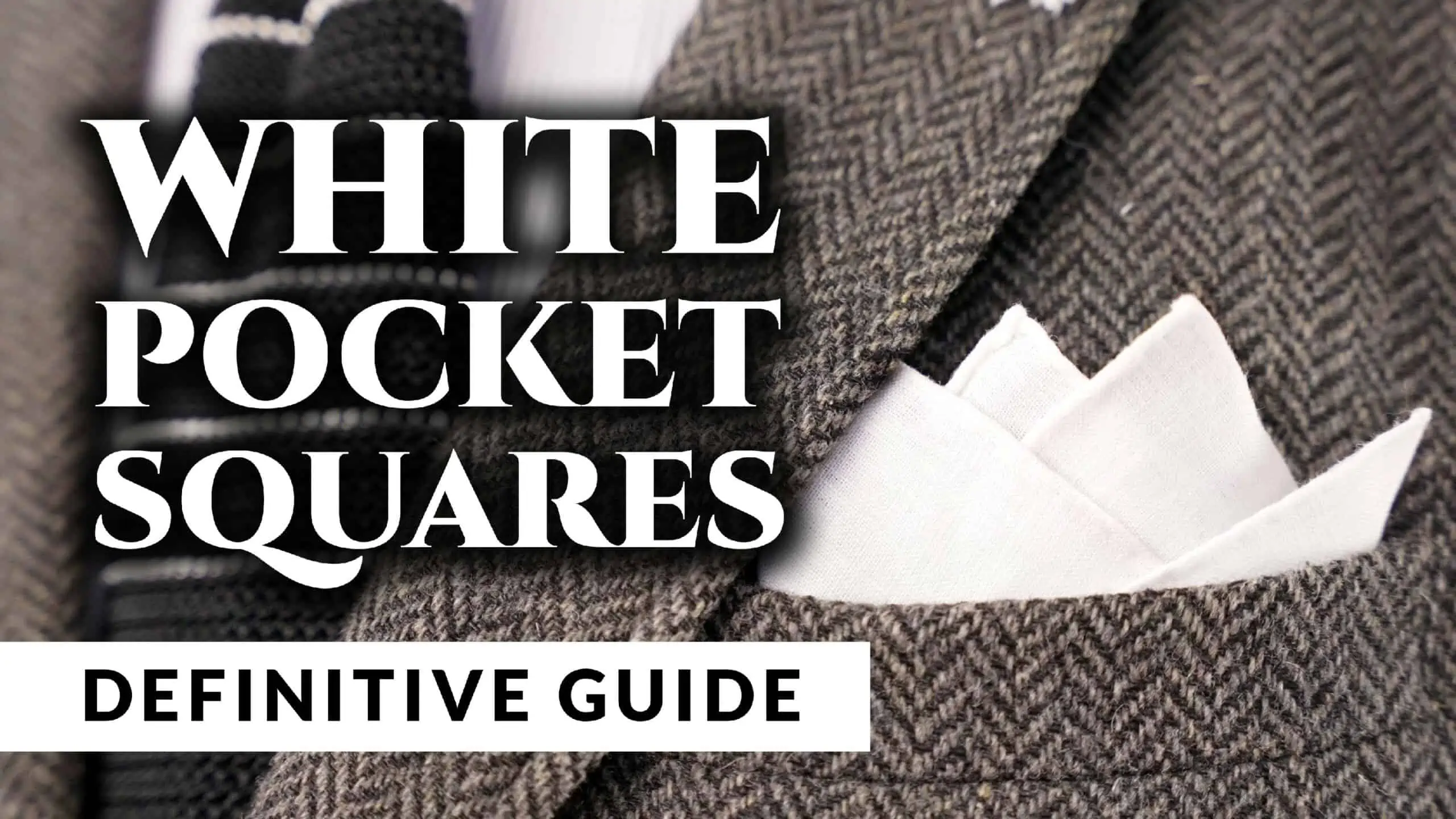
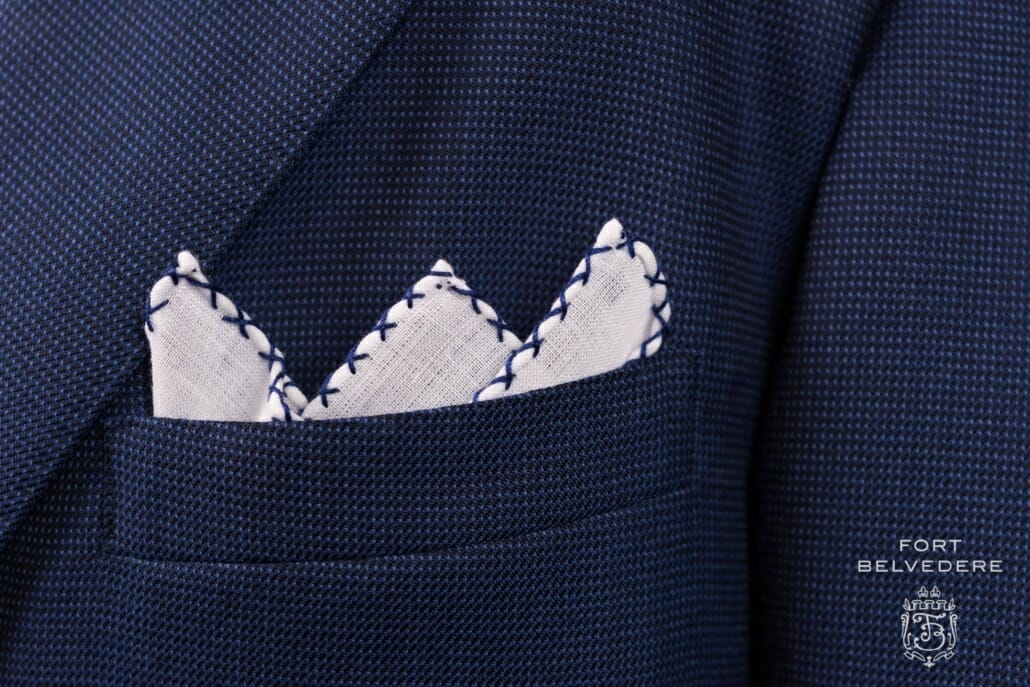
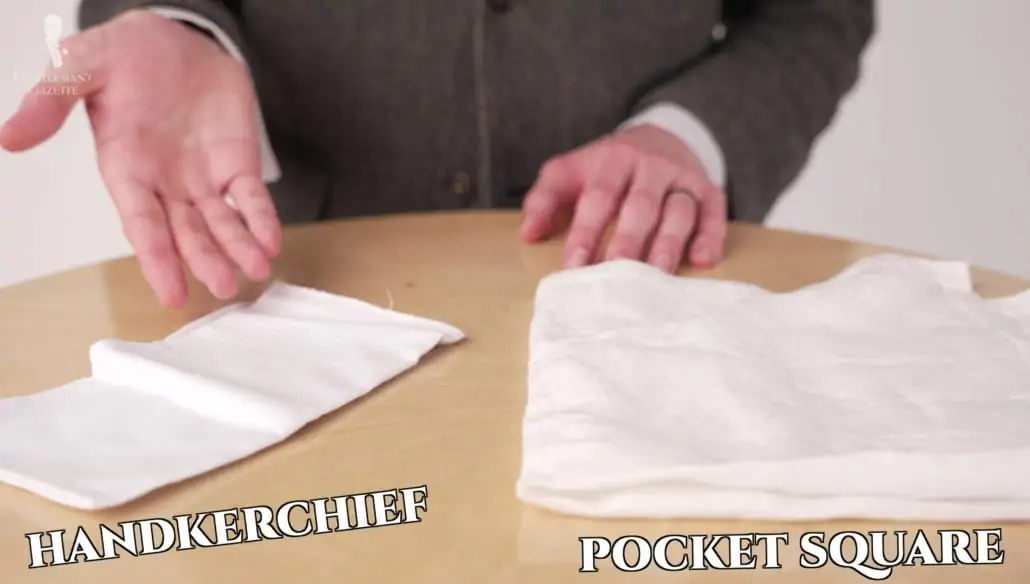
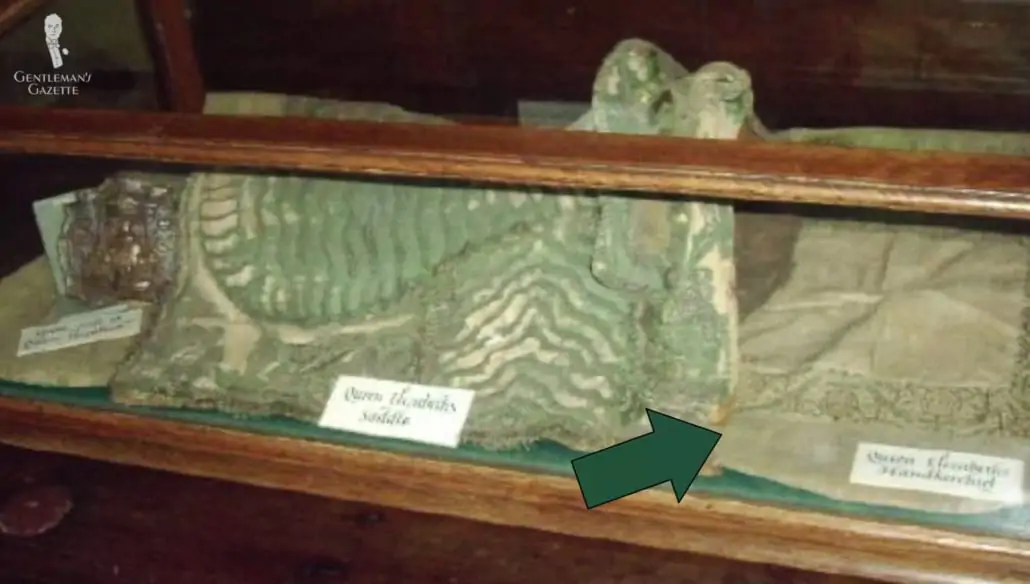
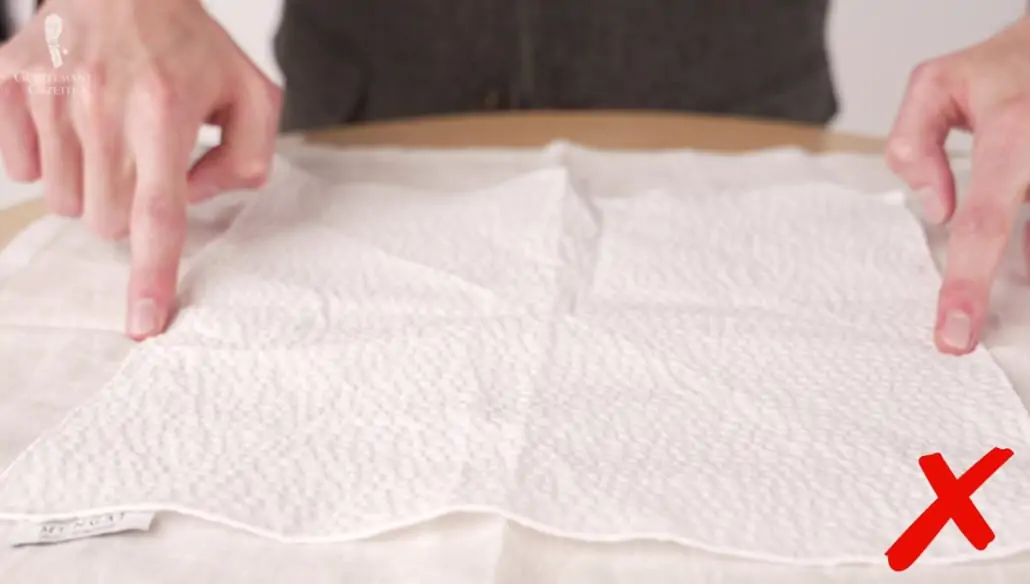
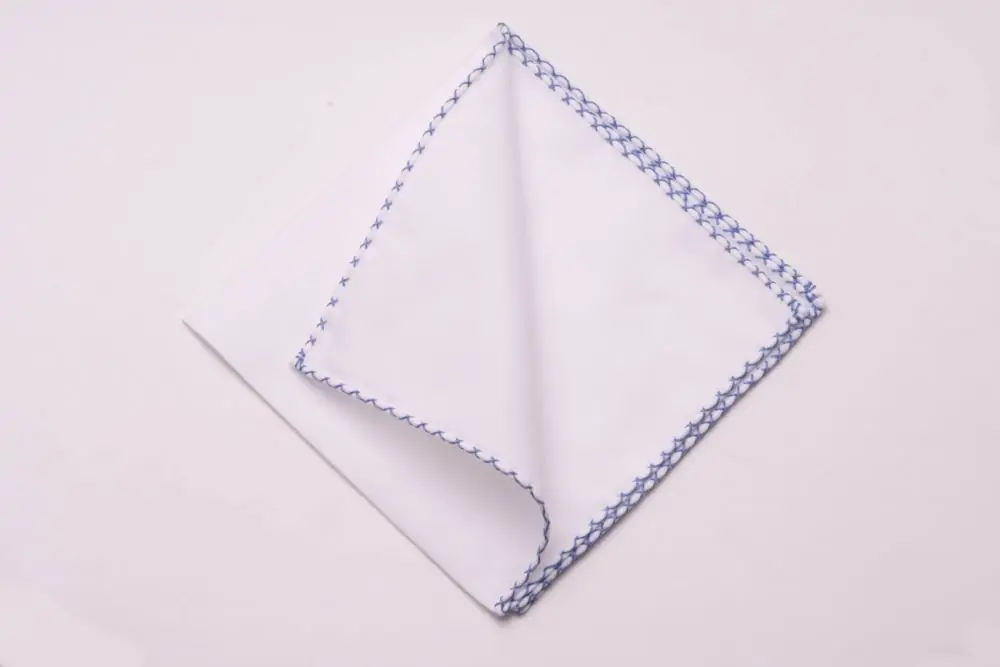
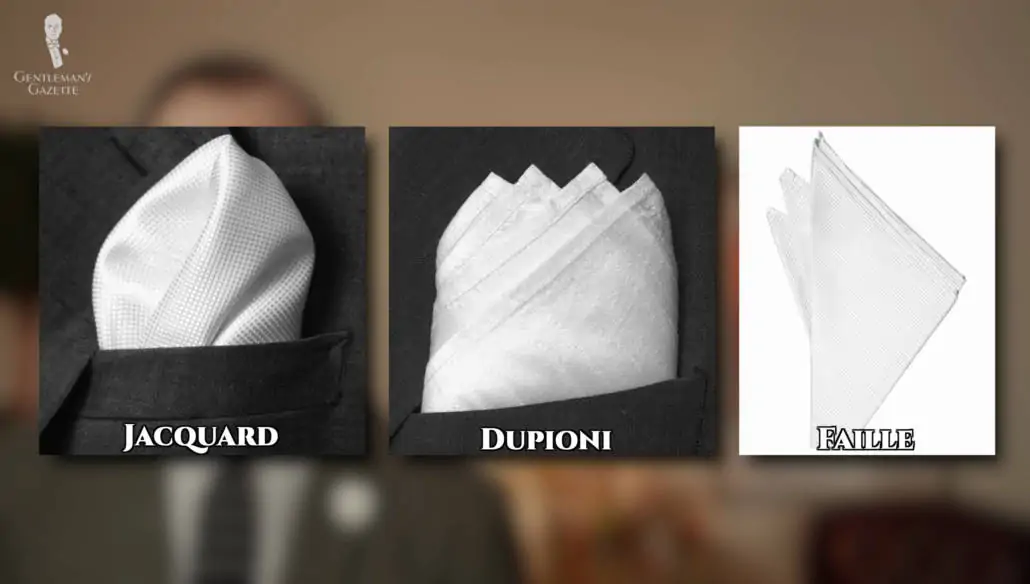
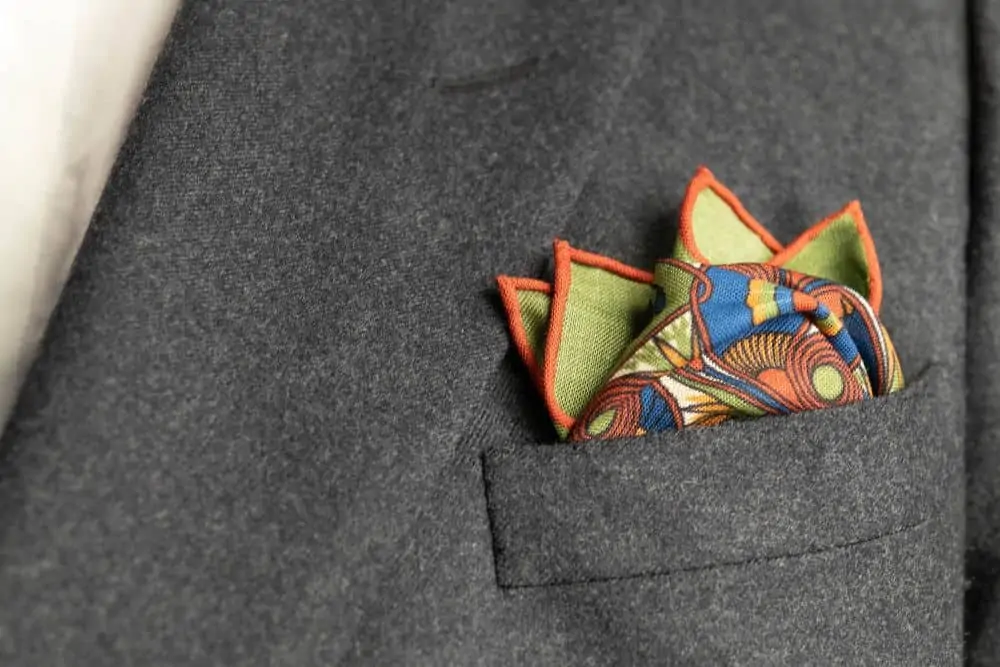
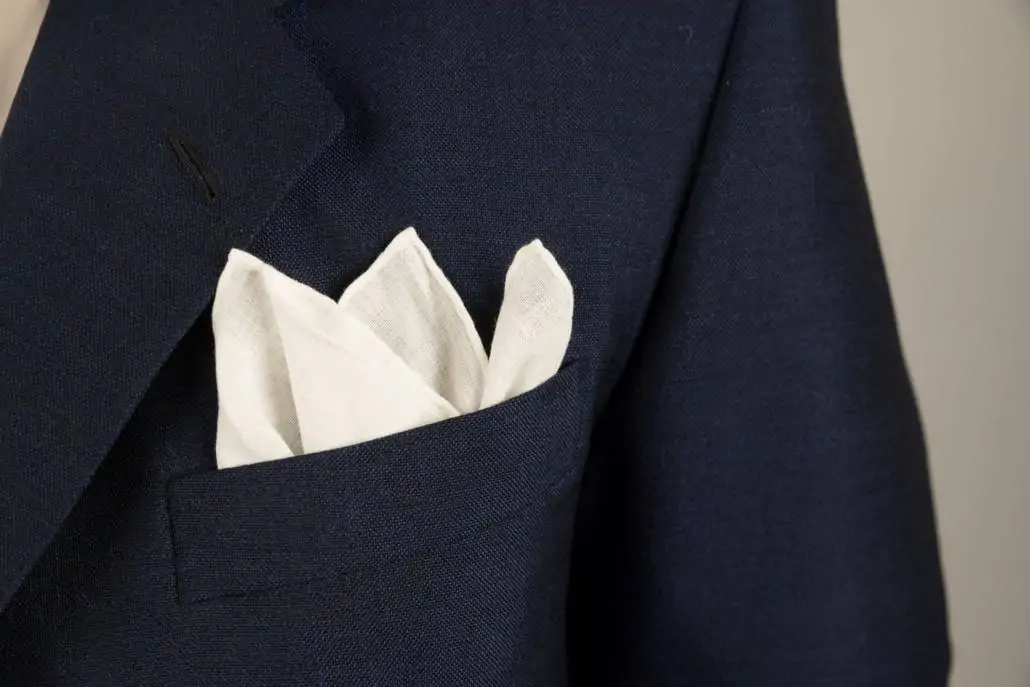
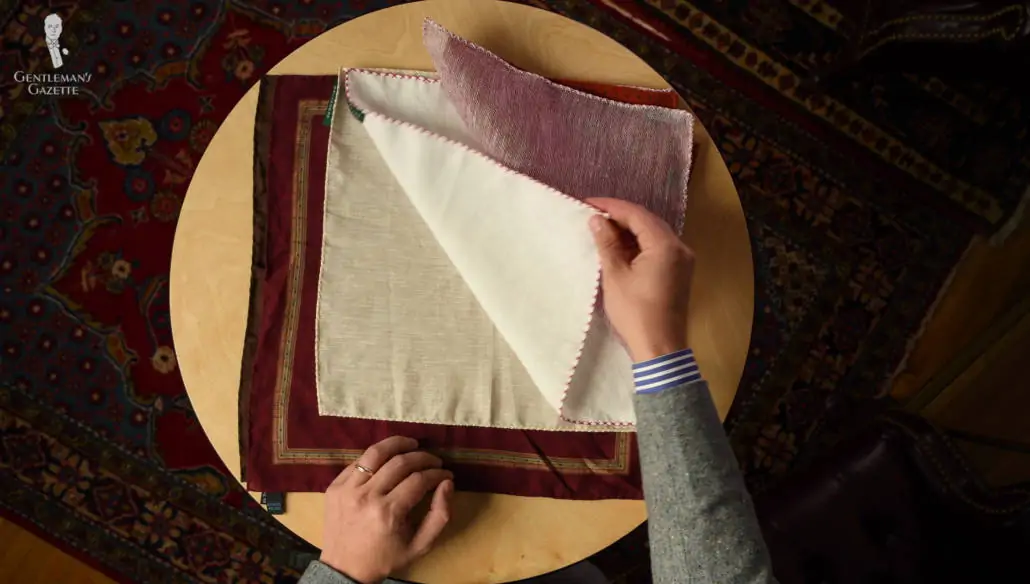
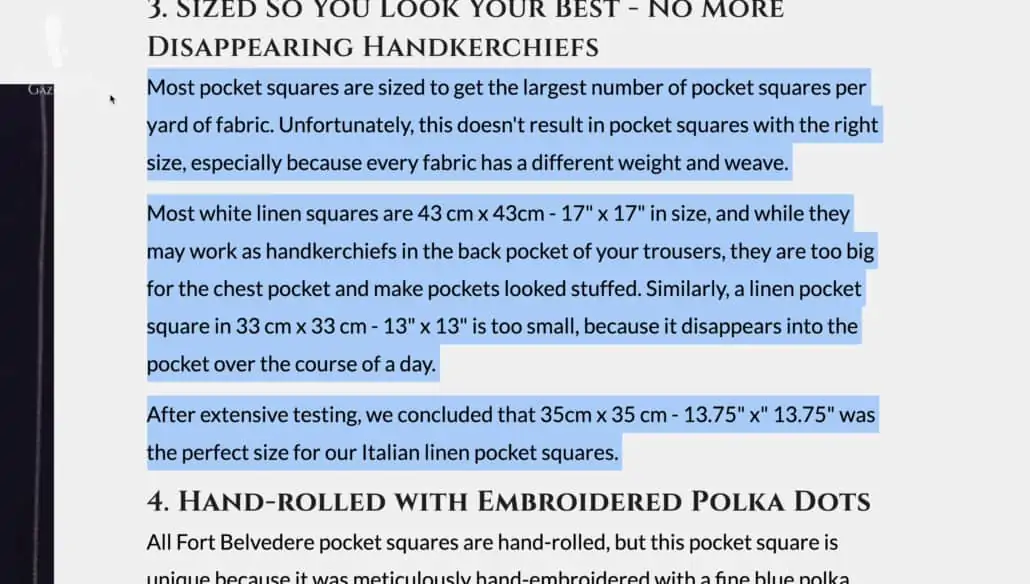
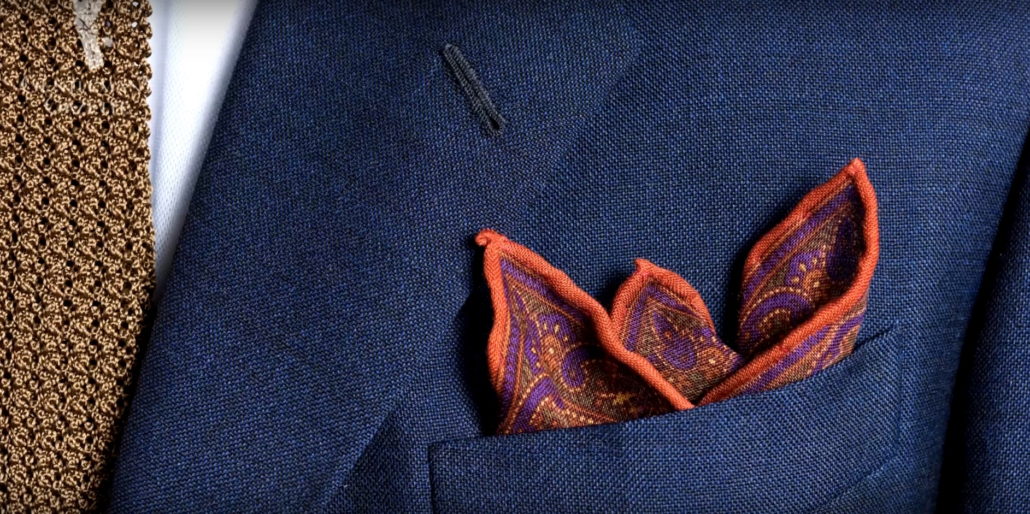
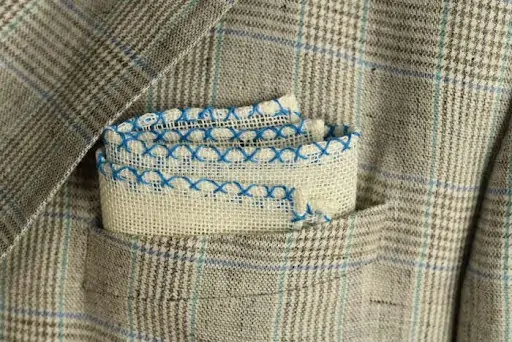
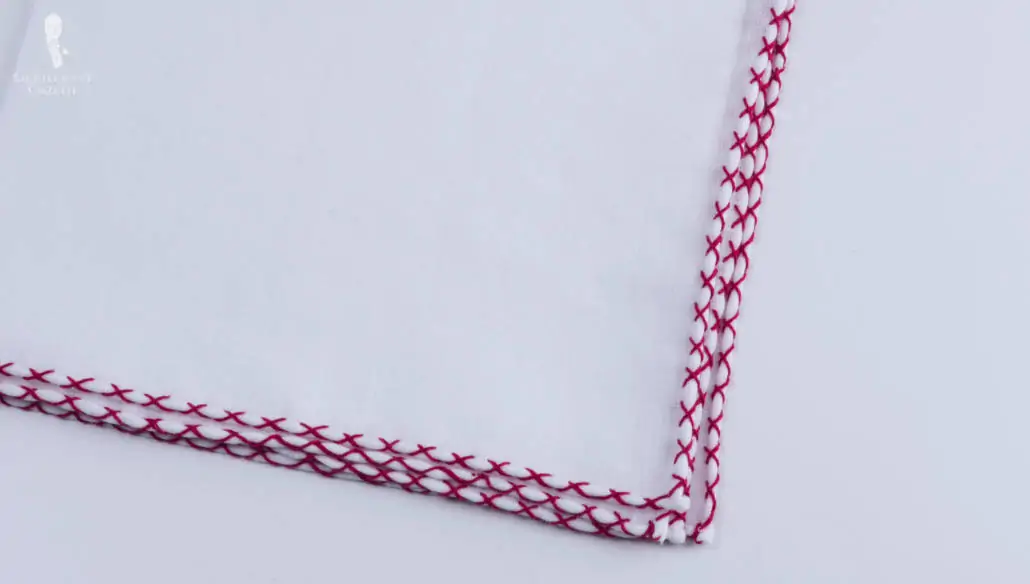
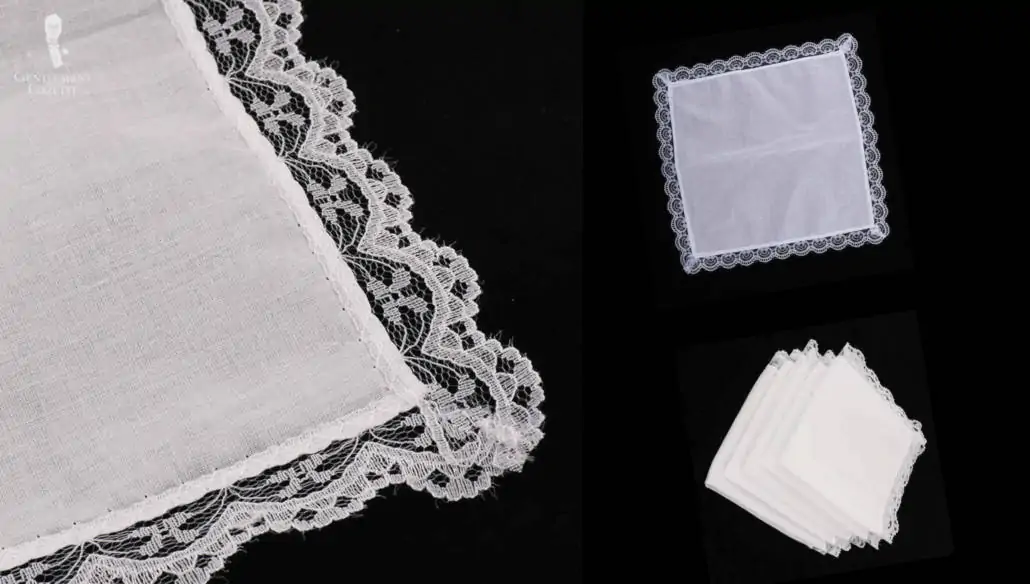
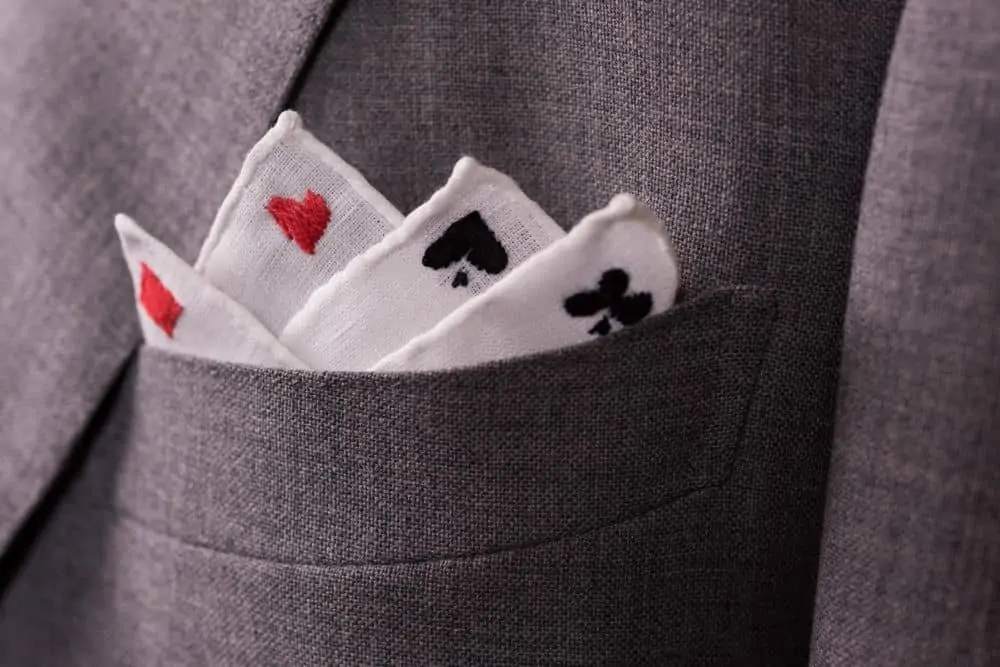
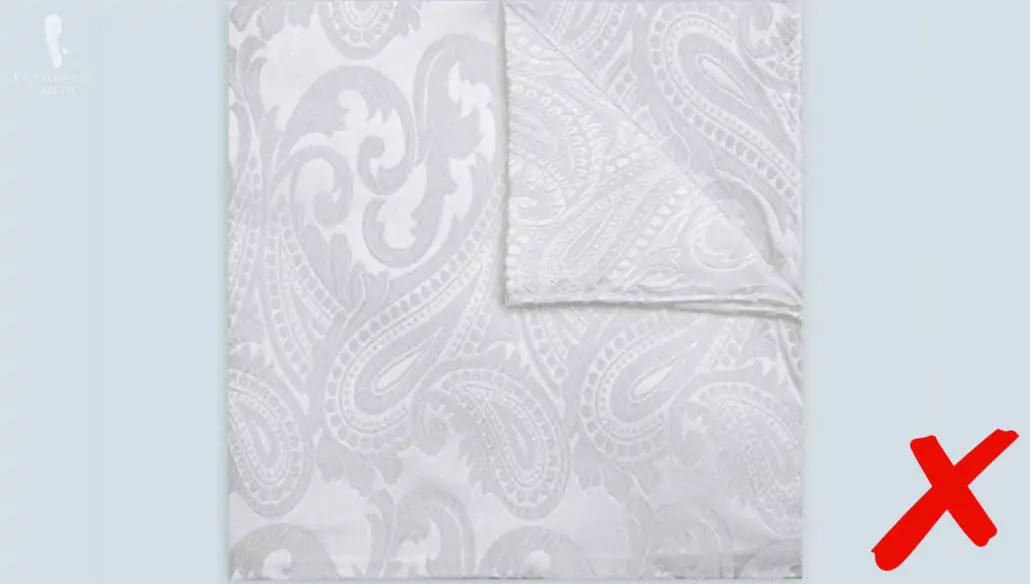
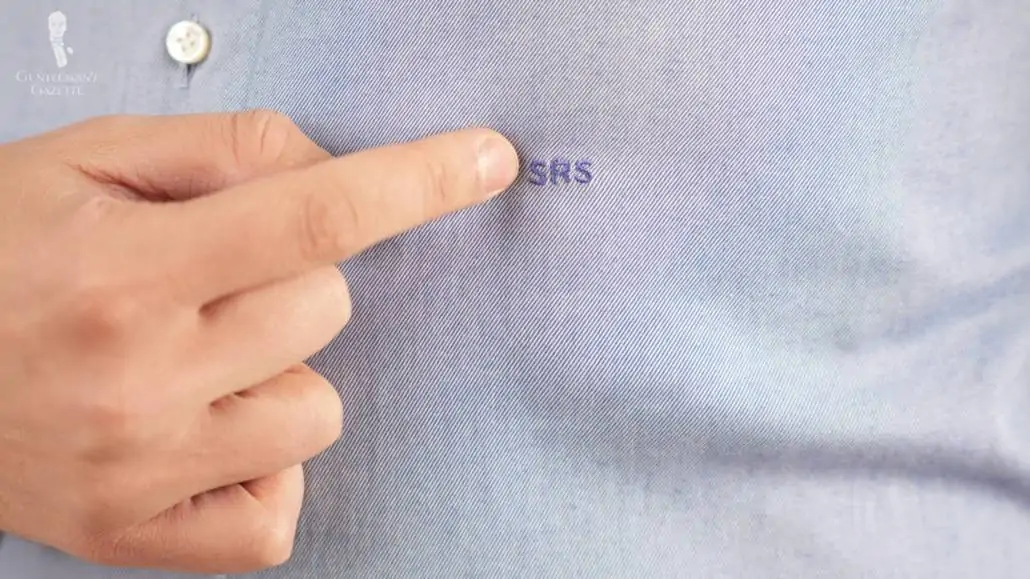
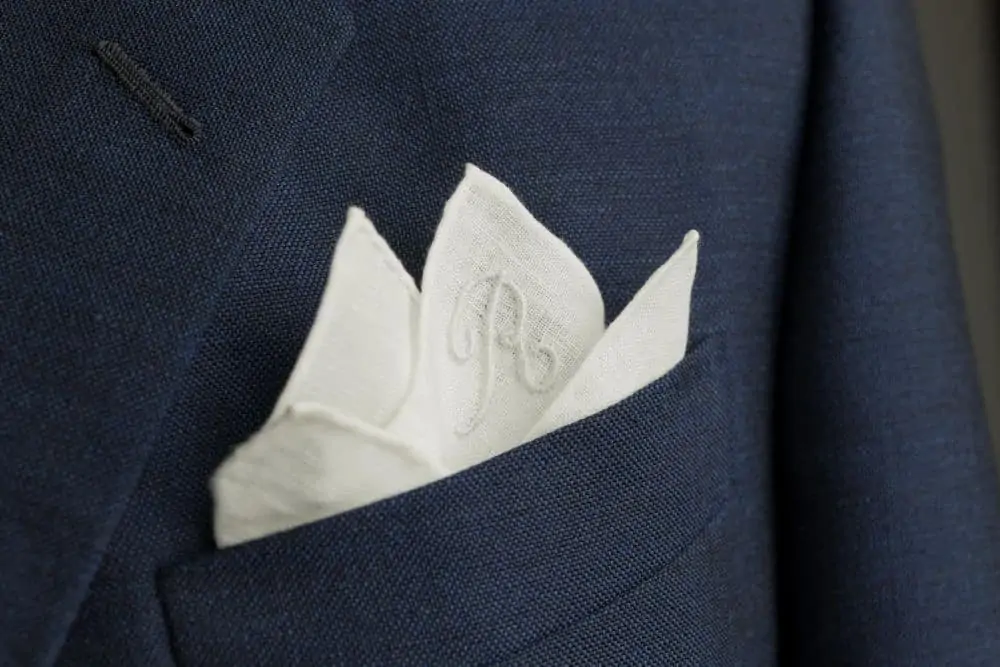
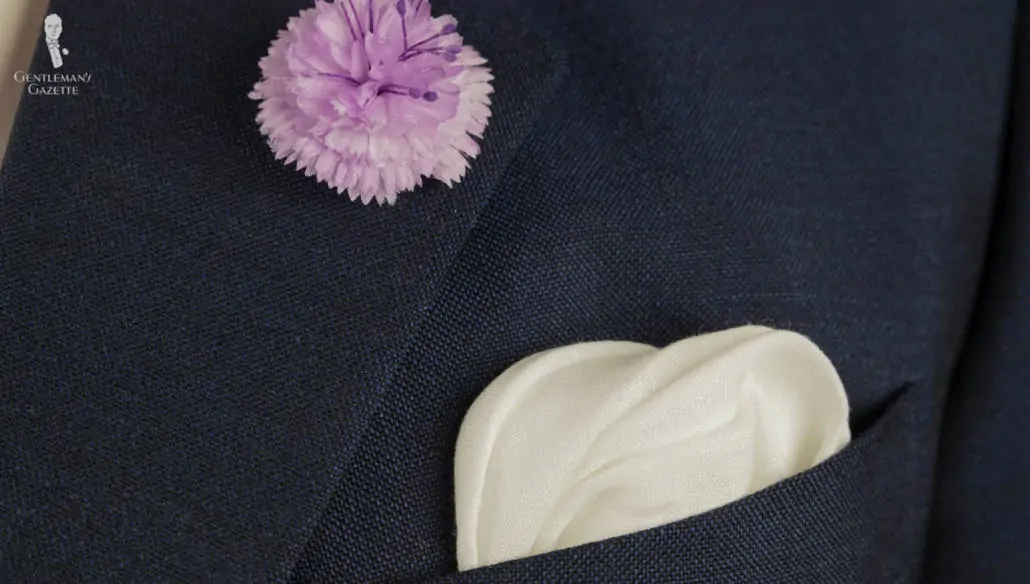
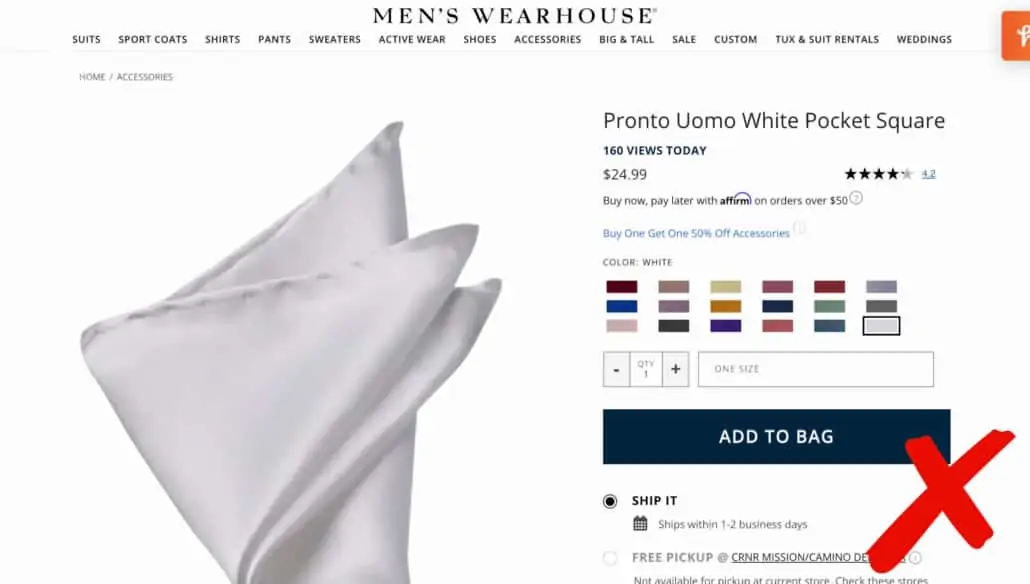
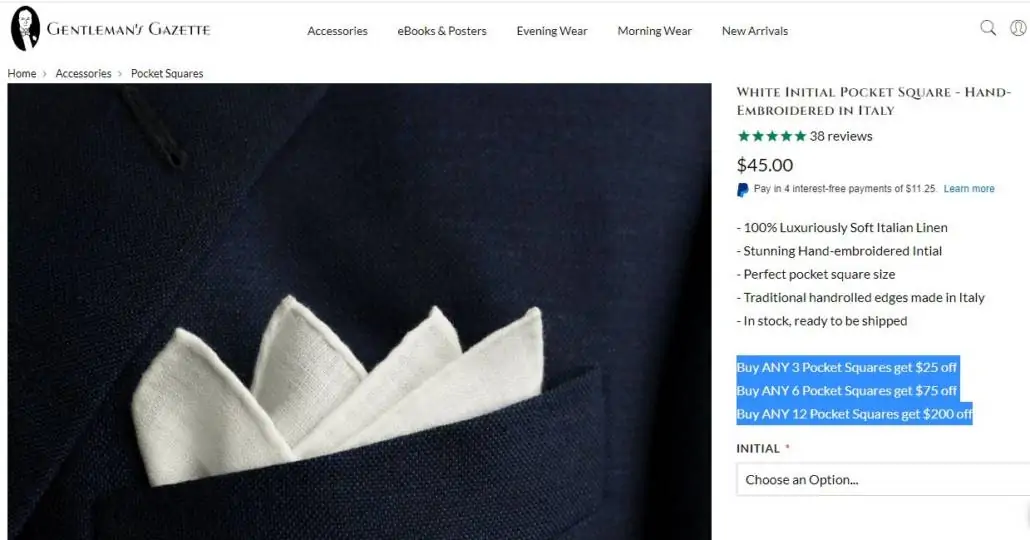
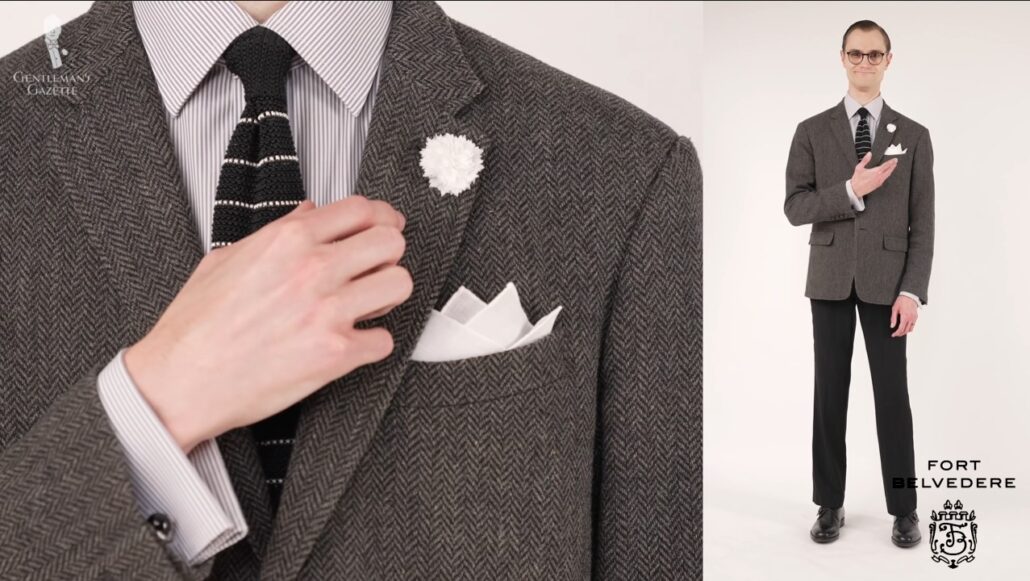
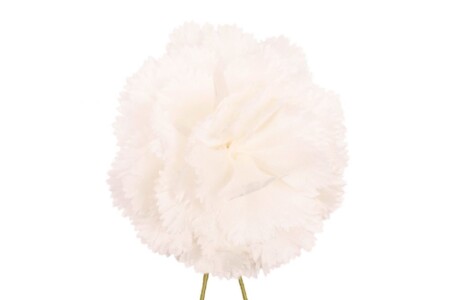
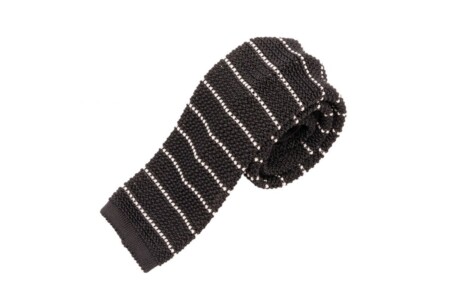
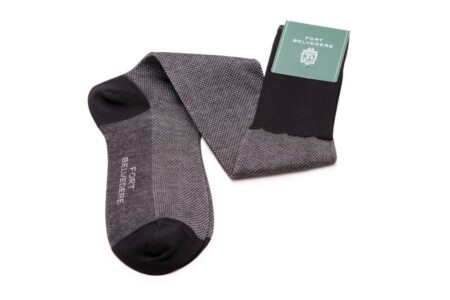
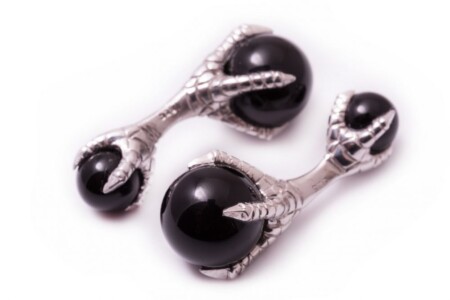
10 square inches? I am afraid you are incorrect, 10 square inches would be 3.16 X 3.16 inches I believe you mean 10 inches square…
Quite right, Wayne! Thanks for the nudge; all such phrasing in the article has been corrected. Glad we could get that “squared away!”
Excellent presentation. Something as simple as a pocket square has so much complexity. (That might be an oxymoron.) You have opened the door for me on some new ideas.I have worn pocket squares for several years and now I am about to order a couple of new ones.
A question regarding the wearing of these. In some British productions, I have seen the pocket square “blossoming out” of the breast pocket. This is especially notable by the veterinarian Sigfreid Farnon. Was this just a style for the era or is it still acceptable?
Thanks again.
Simple things are rarely easy, easy things are rarely simple. Things get even crazier the more complicated your square color/pattern gets, because the minutia of the folds combined with the fabric complexity change the outcome drastically.
As for blossoming out, whether it’s acceptable/stylish or not depends on the situation. Are you selling menswear? Are you at an opening of a swanky art gallery? Are you at a beach wedding? Go crazy. It’ll be fine. For most other things, keep it simple and restrained. A TV fold or a presidential fold will always be acceptable. A reasonably contained puff (one of my favorites) can work for a lot of situations.
Wearing the pocket square as American do is rather pretentious. Just observe how we, in England wear it. Just admire Prince Charles, a Master of understated sophistication.
Pfft. You haven’t seen a lot of Americans wearing pocket squares, apparently. Just like anywhere else, we’ve got our more flamboyant characters, but they stand out simply because they stand out. Us working folks that know how to rock one properly simply recede into the background because we’ve got things to do.
I am sure there are a lot of people in the UK who wear it not in a way you would approve of and there are many in the US you would approve of… I have definitely seen people from the UK dressed in a much more flamboyant way than Prince Charles.
Off topic but relevant to the video.. What happened to front creases in trousers? Doesn’t look as if you guys bother much, is this purposeful or just sloppy dressing?
I have noticed this as well. I think it makes what are probably very nice trousers look sort of cheap. Just my opinion, but nicely creased trousers elevate the look.
Good article! I’ll need to check out one of the books on how to fold pocket squares. You’re a good resource!
Pocket squares and boutonnieres are tacky.
When I see men wearing them I grin and think to myself, this guy is trying to hard.
M L S,
Used to think along those lines myself. That is until I started wearing them and got nothing but compliments. Generally from the fairer sex.
ZZ Top was right.
Matt D.
I am glad that you like them and they work for you especially with the “fairer sex.” Good for you. I just don’t like them sir.
100% agreed on boutonnieres. 5% agreed on squares. Some guys are still figuring it out how to pull it off. They’re still learning the rules. “Learn the rules like a master so you can break them like an artist” – P.Picasso. If they continue to take a lot of time trying to get the fold JUST RIGHT, yes they’re trying too hard. Put the thing in there and move on. It’s why I often just stick with a reserved puff fold. Shove it in there and go.
The tips here are great! I’ve been a wearer of pocket squares ever since I’ve been wearing a jacket, which started at age 12. Now I know all of the ways of wearing them with confidence. Thank you for another enriching post.